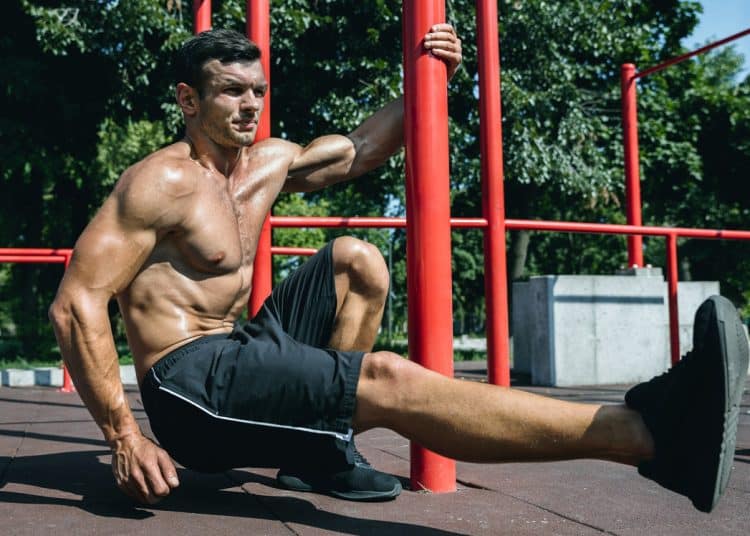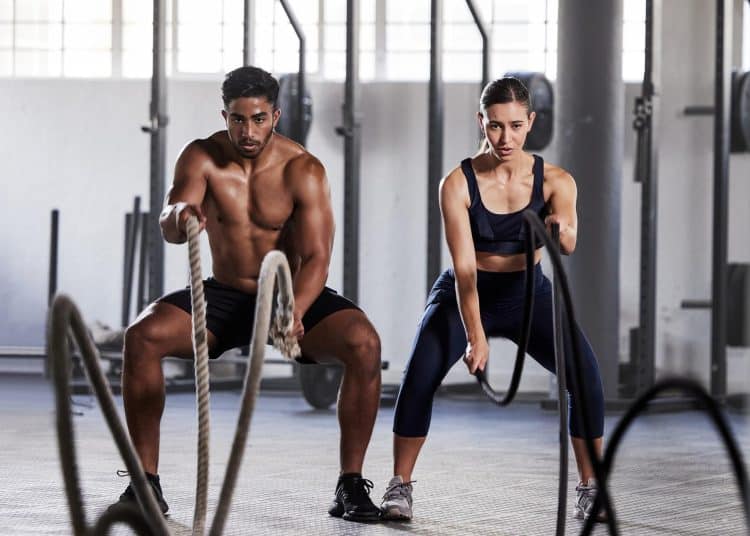After over 30 years working as a personal trainer, I’ve come to the conclusion that strength training is “big medicine.” Combined with daily walking, strength training can help you build the body of your dreams, ward off illness, and help you live a longer, more independent life.
This isn’t just my opinion; many studies support the positive health and fitness benefits of strength training (1, 2). Those benefits include:
- Increased muscle mass
- Improved functional and athletic strength
- Improved walking speed
- Better balance and a reduced risk of falls
- Greater functional independence
- Improved cognitive abilities
- Reduced incidence of anxiety and depression
- Increased confidence and self-esteem
- Reduced resting heart rate and blood pressure
- Decreased low-density lipoprotein cholesterol and triglycerides
- Increased high-density lipoprotein cholesterol
- Improved insulin sensitivity and lower blood glucose
- Reduced visceral fat
- Increased bone mineral density
- Fewer incidences of low back and arthritic pain
- Reversal of age-related muscle and bone density decreases
- Reduced all-cause and cancer-related mortality
However, while the benefits of strength training are well known, a lot of people are confused about what strength training actually is. That’s because strength training is a wide-reaching term encompassing many different types of exercise.
This raises the question: Which type of strength training should you do?
In this article, I discuss 13 different types of strength training and explain their purposes so you can choose the right one for your needs and goals.
Different Types of Strength Training
With so many types of strength training to choose from, it can be hard to know which one you should do. However, because of the fitness principle of specificity, it’s usually best to choose the one that best matches your goals.
Level Up Your Fitness: Join our 💪 strong community in Fitness Volt Newsletter. Get daily inspiration, expert-backed workouts, nutrition tips, the latest in strength sports, and the support you need to reach your goals. Subscribe for free!
Keep reading to discover the main types of strength training and how they affect your body. Armed with this information, choosing the right workout will be much easier.
1. Bodybuilding

Bodybuilding is arguably the most recognizable form of strength training. The aim of bodybuilding is to develop large muscles and an aesthetically pleasing physique. Bodybuilders usually train different muscles on different days using a variety of exercises. This is called a split routine.
While there are competitive bodybuilders, many such exercisers only work out to enhance their appearance or improve their health. Bodybuilding training is suitable for men and women.
While bodybuilders are strong, strength is not their primary concern. However, bodybuilding is not just about looks, and there are many benefits to this type of strength training, including increased muscle mass, lower body fat, and improvements in bone density.
Want to train like a bodybuilder? Check out this five-day bodybuilding routine!
2. Powerbuilding
Where bodybuilders are massively muscular, and powerlifters are incredibly strong, powerbuilders want to be both. This type of strength training combines elements of bodybuilding and powerlifting to maximize muscle size and strength.
Powerbuilding is an excellent option for anyone who wants to build size and strength for sports, e.g., football, hockey, rugby, etc.
You can create your own training program by combining bodybuilding and powerlifting workouts. Alternatively, here are some tried and tested powerbuilding routines to try.
3. Powerlifting
Powerlifting revolves around three barbell lifts – the squat, bench press, and deadlift. Powerlifters build their workouts around these movements, aiming to maximize their one-rep maximum in each lift. Consequently, the main focus of powerlifting is building brute strength.
However, powerlifting workouts also include secondary or assistance exercises, which are chosen to improve performance in the “big three” primary lifts. While powerlifting is a competitive sport, many people follow powerlifting programs with no intention of entering a meet. They just want to get as strong as possible.
Want to try your hand at powerlifting? Here’s a ten-week powerlifting training program to try.
4. Olympic Lifting
Like powerlifting, Olympic lifting is a competitive sport. However, instead of specializing in the barbell squat, bench press, and deadlift, Olympic lifters focus on the snatch and clean and jerk. These movements involve lifting a weight from the floor to overhead.
As well as being a bonafide sport, Olympic lifting, also known as weightlifting, is one of the best ways to develop muscle power. Muscle power is your ability to generate lots of force very quickly. As such, weightlifting is also popular with athletes from all sports.
Check out our beginner’s guide to Olympic weightlifting to learn more about this type of strength training.
5. Strength Athletics Training
Formally known as strongman training, strength athletics training is all about getting as strong as possible in various static and dynamic movements. Classic strength athletics disciplines include axle deadlifts, squats, log presses, truck pulls, keg tosses, power stairs, farmer’s walks, and Atlas stones.
Needless to say, such a specialized type of strength training requires the right kind of gym. However, you can replicate some strength athletics exercises in a commercial facility. Check out this guide to find out how.
6. Calisthenics Training
Most forms of strength training use barbells, dumbbells, or resistance machines. While these tools are excellent for building strength and muscle size, it unfortunately means you’ll probably need to go to a gym to work out.
In contrast, calisthenic or bodyweight exercises require minimal equipment so that you can train anywhere and anytime. This makes calisthenics the perfect excuse-free workout. Consequently, calisthenics is very popular in the military, where good training facilities are often hard to find.
And don’t worry – studies reveal that calisthenic exercises are just as effective as conventional exercises for building muscle and strength (3).
Related: Calisthenics Workout Plan: A Beginner’s Guide & The 11 Best FREE Calisthenics Programs
7. Suspension Training
Suspension training is a variation of calisthenics. However, instead of doing all your exercises on the floor or from a stable bar, you use freely moving handles attached to straps. This increases instability and range of motion, delivering a more demanding workout while increasing the number of exercises you can do.
Level Up Your Fitness: Join our 💪 strong community in Fitness Volt Newsletter. Get daily inspiration, expert-backed workouts, nutrition tips, the latest in strength sports, and the support you need to reach your goals. Subscribe for free!
The TRX is a popular suspension trainer, and lower-priced TRX alternatives are available. You can also use gymnastic rings as a suspension trainer.
Try our Suspension Trainer Bodybuilding Workout Plan to see how effective this type of strength training can be!
8. Isometric Training
Like calisthenics, isometric training is a low-tech but high-effect way to build strength and muscle mass. With isometrics, you push or pull against an immovable object, creating tension and fatigue in your muscles without moving.
Before you write isometrics off as a fad or ineffective, it’s worth noting that this type of strength training has been popular for centuries and is supported by an abundance of research (4). Requiring very little equipment, except maybe a yoga strap or towel, isometrics is ideal for home exercisers. It’s also very joint-friendly.
You can learn more about isometric training in our detailed guide.
9. Resistance Band Training
Lifting weights is one of the most popular ways to develop muscle size and strength, but it’s not the only way. That’s good news because weights can be expensive to buy and can even be dangerous if you train alone.
Resistance bands are light, portable, and cheap. Plus, with no inertia to overcome, they’re also much easier on your joints. You can use resistance bands to replicate almost every freeweight and resistance machine exercise. You can also combine them with most bodyweight exercises to make them more challenging.
Got bands? Make the most of them with our Full-Body Resistance Band Workout for Home Exercisers!
10. Kettlebells, Clubbells, Macebells, Medicine Balls, etc.
Kettlebells, clubbells, macebells, medicine balls, sandbags…all these things might seem unusual, but they’re actually traditional strength training tools. In some cases, they predate conventional workout equipment by hundreds of years.
Depending on the apparatus used, you can lift, press, swing, or even throw these items to build all-around strength and muscle mass.
So, if you are bored of training with barbells, dumbbells, or machines, give these alternative training tools a try. They could just be the new but old workout you are looking for!
See also:
- 12 Best Kettlebell Exercises for Hypertrophy, Strength and Function
- Steel Club Exercises: Boosting Shoulder Strength and Mobility
- Mace Training: Ancient Weapon, Modern Workout
- 15 Medicine Ball Exercises for Full Body Workouts, Fat-Burning, And Stronger Core
11. Functional Training
Functional training has become a fitness industry buzzword during the last few years. Simply put, functional training aims to build strength that transfers to activities outside of the gym. This will make everyday tasks easier or improve your sports performance. Either way, functional exercises enhance physiological function, hence their name.
Functional training can involve various methods, from cables to freeweights to bodyweight exercises. However, you won’t find any machines in most functional workouts as the weights are guided and move in straight lines, which is deemed non-functional.
You can learn more about the pros and cons of functional strength training in this comprehensive guide.
12. Plyometric Training
Whether you want to jump higher, throw further, kick harder, or run faster, plyometric training will help. That’s because plyometrics build explosive strength, also known as power. Power is your ability to generate force quickly.
Plyometric exercises typically involve a rapid loading phase followed by a rapid muscle contraction. Examples of plyometric exercises include squat jumps, clap push-ups, and medicine ball throws.
Plyometrics is an advanced form of training that you should only attempt after building a foundation of strength and fitness using more conventional strength training. As such, this is the ideal training method for experienced exercisers and athletes.
Related: 10 Best Plyometric Exercises to Build Explosive Power & The 10 Best Plyometric Exercises for Upper Body Explosive Power
13. Circuit Training
So, you want to get strong, build some muscle, burn fat, and get fit, but can only work out a few times a week? The solution is circuit training!
Circuit training involves doing multiple strength exercises back-to-back. This creates a fantastic fat-burning, fitness-boosting workout despite not including any cardio. Circuit training is one of the most comprehensive, time-efficient ways to train, making it ideal for time-pressed exercisers.
You can modify circuit training to meet almost any goal, and it’s also suitable for all levels of fitness and experience. However, it will make you a “jack of all trades but master of none,” so if you have more specific strength or fitness needs, you should address those separately.
Related: Circuit Training vs. Cross Training: Definitions, Benefits, and Which One Should You Do? & Circuit Training vs. HIIT For Fitness and Fat Loss
Closing Thoughts
Armed with these 13 different types of strength training, you have all the information you need to choose the best workout style to match your needs and goals. However, it’s important to stress that you don’t have to pick just one, and many of these methods can be combined to create your own hybrid workouts.
The fact is that all strength training works in much the same way – by overloading your muscles. And while different training methods produce somewhat different results, they’re more similar than many people realize.
So, don’t feel you must stick to bodybuilding, powerlifting, calisthenics, or functional training. Instead, you can pick and choose from all these methods to create the workout program that’s right for you.
Finally, remember this: when it comes to strength training, almost all workouts are good workouts, and the only bad workout is the one you didn’t do!
References:
- Shailendra P, Baldock KL, Li LSK, Bennie JA, Boyle T. Resistance Training and Mortality Risk: A Systematic Review and Meta-Analysis. Am J Prev Med. 2022 Aug;63(2):277-285. doi: 10.1016/j.amepre.2022.03.020. Epub 2022 May 20. PMID: 35599175.
- Westcott WL. Resistance training is medicine: effects of strength training on health. Curr Sports Med Rep. 2012 Jul-Aug;11(4):209-16. doi: 10.1249/JSR.0b013e31825dabb8. PMID: 22777332.
- Tillaar RVD. Comparison of Kinematics and Muscle Activation between Push-up and Bench Press. Sports Med Int Open. 2019 Sep 5;3(3):E74-E81. doi: 10.1055/a-1001-2526. PMID: 31508485; PMCID: PMC6728153.
- Zou Z, Morimoto N, Nakatani M, Morinaga H, Takai Y. Effects of Different Isometric Training Programs on Muscle Size and Function in the Elbow Flexors. Int J Environ Res Public Health. 2023 Feb 21;20(5):3837. doi: 10.3390/ijerph20053837. PMID: 36900849; PMCID: PMC10001567.
Article Updates Timeline:
Our editorial team experts constantly update the articles with new information & research, ensuring you always have access to the latest and most reliable information.
February 24, 2024
Written By
Patrick Dale, PT, ex-Marine
Reviewed By
Editorial Team












